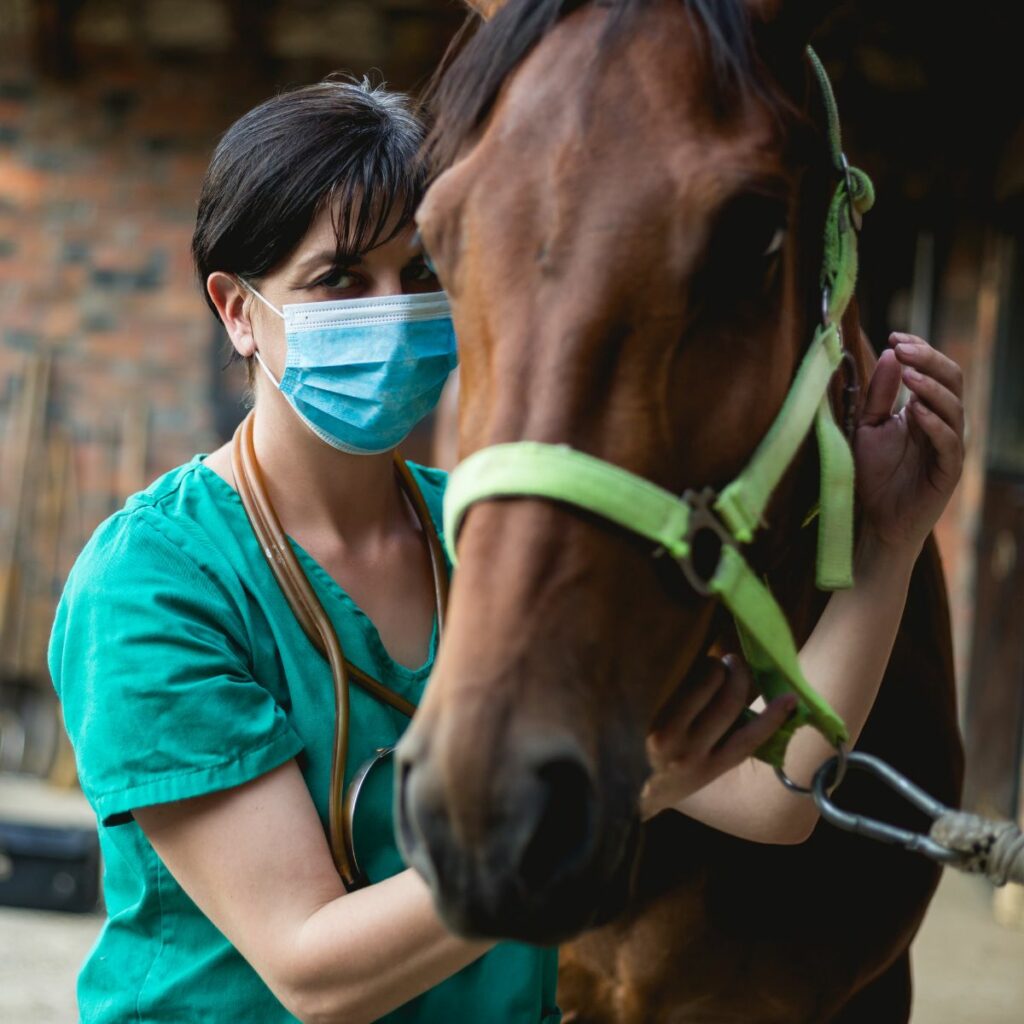As an Amazon Associate we earn from qualifying purchases.
Equine Protozoal Myeloencephalitis (EPM) is a neurological disease that affects horses and is caused by the protozoan Sarcocystis neurona. The disease can cause a range of symptoms, including weakness, ataxia, muscle wasting, and paralysis. EPM is a serious condition that can have a significant impact on a horse’s quality of life, and in severe cases, it can be fatal. But how long can a horse live with EPM?
The prognosis for horses with EPM can vary depending on the severity of the disease and the stage at which it is diagnosed. In some cases, horses may recover fully with appropriate treatment, while in others, the disease may progress despite treatment. It is important to note that not all horses exposed to Sarcocystis neurona will develop EPM, and the severity of the disease can vary widely between individuals. Factors that can affect the prognosis for horses with EPM include the age and overall health of the horse, the severity of the clinical signs, and the response to treatment.
Understanding EPM in Horses
Equine Protozoal Myeloencephalitis (EPM) is a neurological disease that affects horses. It is caused by protozoa, specifically Sarcocystis neurona and Neospora hughesi. The disease can lead to severe neurological damage and even death if not treated promptly.
Role of Opossums in EPM
Opossums play a significant role in the transmission of EPM. They are the definitive host of Sarcocystis neurona, the protozoan responsible for most cases of EPM. Opossums become infected by ingesting sporocysts, which are shed in the feces of infected horses. The sporocysts then develop into sporozoites, which invade the opossum’s intestinal wall and migrate to the nervous system, where they form tissue cysts.
However cute they look these animals are the main carrier and cause of transmission of EPM in horses!

When an opossum defecates, it sheds sporocysts in its feces, which can contaminate pastures and feed. Horses can become infected by ingesting sporocysts from contaminated feed or water. Once inside the horse’s digestive system, the sporocysts release sporozoites, which can then migrate to the nervous system and cause EPM.
Other Potential Hosts of EPM
While opossums are the definitive host of Sarcocystis neurona, other animals can also become infected and serve as intermediate hosts. These include skunks, armadillos, cats, and raccoons. While these animals can become infected with S. neurona, it is not clear whether they can transmit the disease to horses.
Neospora hughesi, another protozoan that can cause EPM, is thought to be transmitted by dogs. However, the exact mechanism of transmission is not well understood.
In conclusion, understanding the transmission of EPM is essential in preventing and treating the disease. Opossums play a significant role in the transmission of Sarcocystis neurona, the protozoan responsible for most cases of EPM. Other animals can also become infected with S. neurona, but their role in the transmission of the disease is not well understood.
Symptoms of EPM in Horses
Equine Protozoal Myeloencephalitis (EPM) is a neurological disease that can affect horses of all ages, breeds, and sexes. The symptoms of EPM can vary widely from one horse to another. Some horses may show only mild symptoms, while others may be severely affected. In this section, we will discuss some of the most common symptoms of EPM.
One of the most common symptoms of EPM is weakness. Horses with EPM may become weak in their limbs, making it difficult for them to stand or walk properly. This weakness can be caused by damage to the spinal cord or nerves that control the muscles.
Ataxia is another common symptom of EPM. Ataxia is a lack of coordination that can affect a horse’s gait and balance. Horses with ataxia may stumble, trip, or fall, and they may have difficulty standing up or turning around. Muscle atrophy, or the loss of muscle mass, can also occur in horses with EPM.
Incoordination is another symptom of EPM. Horses with EPM may have difficulty coordinating their movements, making it difficult for them to perform tasks such as walking, turning, or backing up. This can be caused by damage to the cerebellum, which is the part of the brain that controls coordination.
Lameness is another symptom of EPM. Horses with EPM may become lame in one or more limbs, making it difficult for them to walk or run properly. This lameness can be caused by damage to the nerves that control the muscles of the limbs.
Seizures are a less common symptom of EPM, but they can occur in some horses. Seizures can cause a horse to lose consciousness, fall to the ground, and convulse. Head tilt and lethargy can also occur in horses with EPM, as well as behavioral changes such as depression or aggression.
Overall, the symptoms of EPM can be varied and may affect horses differently. If you suspect that your horse may have EPM, it is important to consult with a veterinarian as soon as possible. Early diagnosis and treatment can help to improve the horse’s chances of recovery.
Diagnosing EPM in Horses
Diagnosing equine protozoal myeloencephalitis (EPM) can be challenging, as the clinical signs of the disease can be similar to those of other neurological diseases. A veterinarian will typically perform a thorough physical and neurological examination of the horse, taking note of any abnormalities in gait, muscle tone, and reflexes.
Quick diagnosis can increase the length of time a horse can live with EPM.
To confirm a diagnosis of EPM, veterinarians may use a combination of tests, including blood tests, cerebrospinal fluid analysis, and spinal taps. Blood tests can help detect antibodies to the protozoa that cause EPM, but they are not always reliable. Cerebrospinal fluid analysis can provide more accurate results, as the fluid surrounds the brain and spinal cord, where the damage from EPM occurs.
In some cases, a veterinarian may perform a spinal tap to collect cerebrospinal fluid for analysis. This procedure involves inserting a needle into the horse’s spinal canal and removing a small amount of fluid. While spinal taps can be risky, they can provide valuable information for diagnosing EPM.
Symptoms of EPM can vary depending on the location of the damage in the nervous system. Some horses may exhibit mild symptoms, such as muscle weakness or loss of coordination, while others may experience more severe symptoms, such as paralysis or seizures.
It is important to note that not all horses with EPM will exhibit clinical signs. In some cases, a horse may be infected with the protozoa that cause EPM but show no outward symptoms of the disease.
Overall, diagnosing EPM requires a thorough examination by a veterinarian, as well as specialized tests to confirm the presence of the protozoa that cause the disease. While the diagnosis can be challenging, early detection and treatment can improve the horse’s chances of recovery.
Treatment and Recovery

Equine Protozoal Myeloencephalitis (EPM) is a serious disease that can cause significant neurological damage to horses. The treatment of horses suspected to have EPM should be done as soon as possible to increase their chances of recovery. The success of the treatment depends on the severity of the disease and the quality of treatment provided.
The quality and timely delivery of proper veterinary care can be crucial in how long a horse can live with EPM.
There are several drugs available for the treatment of EPM, including sulfadiazine and pyrimethamine, which are commonly used in combination. Marquis, ponazuril, Protazil, and diclazuril are other drugs that have been used for the treatment of EPM. The choice of drug and the duration of treatment depend on several factors, including the severity of the disease and the response of the horse to the treatment.
Recovery from EPM can take several weeks to several months, and horses with severe neurological deficits are less likely to survive than horses with mild deficits. The success of the treatment also depends on the quality of care provided to the horse during the recovery period. Rebalance, a nutritional supplement containing Vitamin E, has been shown to aid in the recovery of horses with EPM.
It is important to note that the diagnosis and treatment of EPM should be done by a veterinarian with experience in treating the disease. The proper diagnosis of EPM in horses is critical for successful treatment and recovery. If left untreated, EPM can cause permanent neurological damage and even death in horses. Therefore, prompt and accurate diagnosis and treatment are essential for the successful recovery of horses with EPM.
In conclusion, the treatment and recovery of horses with EPM depend on several factors, including the severity of the disease, the choice of drug, and the quality of care provided during the recovery period. With proper diagnosis and treatment, horses with EPM can recover and return to their normal activities.
Prevention of EPM
Preventing EPM in horses is crucial because there is no cure for the disease. While it is impossible to completely eliminate the risk of EPM, there are several preventative measures that horse owners can take to reduce the likelihood of infection.
One of the primary ways that horses become infected with EPM is through contact with opossums, which are the definitive host for the Sarcocystis neurona parasite. Horse owners should take steps to discourage opossums from entering their property, such as securing trash cans and removing any potential hiding places.
Water sources can also be a potential source of infection. Horse owners should ensure that their horses have access to clean water that is not contaminated with fecal matter. Additionally, any feed or food sources should be stored in a manner that prevents contamination by opossum feces.
Parasite control is another important aspect of EPM prevention. Horse owners should work with their veterinarian to develop a parasite control program that is tailored to their horse’s specific needs. This may include regular deworming and fecal egg counts to monitor parasite levels.
Horse feed can also play a role in EPM prevention. Horse owners should avoid feeding their horses hay or grain that has been stored in areas where opossums may have access. Additionally, horse feed should be stored in a manner that prevents contamination by opossum feces.
Overall, preventing EPM requires a multi-faceted approach that includes minimizing contact with opossums, ensuring clean water sources, implementing parasite control measures, and being mindful of feed storage and contamination. By taking these preventative measures, horse owners can help reduce the risk of EPM in their horses.
Research and Studies on EPM
Equine Protozoal Myeloencephalitis (EPM) is a serious neurological disease that affects horses. Over the years, there have been several research studies conducted to understand the causes, risk factors, and treatments for EPM.
Another study found that certain risk factors increase the likelihood of a horse developing EPM. These risk factors include a selenium deficiency, a viral disease, and exposure to equine herpesvirus. Thoroughbred horses are also more susceptible to EPM than other breeds.
The severity of infection can vary depending on the horse’s immune system and the stage at which the disease is diagnosed. A study found that horses with severe neurologic deficits were less likely to survive than horses with mild neurologic deficits.
Infectious disease outbreaks can also affect the prevalence of EPM. A study found that there was a higher incidence of EPM in horses during an outbreak of West Nile virus.
Research has also been conducted on the treatment of EPM. One study found that the blood-brain-barrier can limit the effectiveness of certain treatments, making it difficult to fully eradicate the parasite from the horse’s system.
Overall, research on EPM has helped to improve our understanding of this disease and its causes. By identifying risk factors and developing effective treatments, we can help to reduce the prevalence of EPM in horses.
Impact on Horse Owners
Equine Protozoal Myeloencephalitis (EPM) is a deadly disease that affects horses and can be difficult to diagnose. The impact of EPM on horse owners can be significant, both emotionally and financially.
Horses that have been diagnosed with EPM require a lot of care and attention from their owners. Recovery can take weeks or even months, and relapse is always a possibility. In some cases, horses may not recover at all and may have to be euthanized.
The financial impact of EPM can also be significant. Treatment can be expensive, and there is no guarantee that the horse will recover. In some cases, horses may require ongoing treatment, which can be costly.
EPM can also have a significant impact on the horse’s physical well-being. Muscle loss is common in horses with EPM, and inflammation can occur in the spinal cord, which can lead to further complications.
Horse owners should also be aware that EPM is caused by protozoan parasites that are carried by opossums. While it is difficult to prevent horses from coming into contact with opossums, there are steps that horse owners can take to reduce the risk of infection.
Antibodies to EPM can be detected in the serum of infected horses, and there are treatments available that can help to reduce the symptoms of EPM. However, there is no cure for EPM, and horses that have been infected with the disease may be more susceptible to relapse in the future.
In conclusion, EPM can have a significant impact on horse owners, emotionally, financially, and physically. While there are treatments available, there is no cure for this deadly disease, and it is important for horse owners to take steps to reduce the risk of infection.
How Long Can a Horse Live with EPM? Definitive Answer
The duration of survival of a horse with EPM varies depending on the severity of the infection and the horse’s response to treatment. Without diagnosis and treatment, the disease can progress rapidly and become fatal. However, many horses can recover and live a normal life with early and aggressive treatment. The length of treatment can vary from several weeks to several months, and it is important to work closely with a veterinarian to monitor the horse’s progress. Overall, the prognosis for horses with EPM can vary, and it is important to seek veterinary care as soon as possible if you suspect your horse may be infected.
Frequently Asked Questions
What are the symptoms of EPM in horses?
The symptoms of EPM in horses can vary widely and may include ataxia, muscle weakness, muscle atrophy, incoordination, abnormal gait, lameness, and behavioral changes. Horses with severe cases of EPM may also experience difficulty swallowing, head tilt, and facial paralysis.
How is EPM in horses diagnosed?
EPM in horses can be difficult to diagnose, as the symptoms can be similar to those of other neurological conditions. A veterinarian may perform a neurological exam, blood tests, and spinal fluid analysis to determine if a horse has EPM.
What is the typical treatment for EPM in horses?
The typical treatment for EPM in horses involves a combination of anti-protozoal drugs and supportive care. The goal of treatment is to reduce inflammation in the central nervous system and kill the protozoa that are causing the infection.
Can EPM in horses be cured completely?
While some horses may recover completely from EPM, others may experience long-term neurological deficits. The success of treatment depends on the severity of the infection and how quickly it is diagnosed and treated.
What is the long-term prognosis for a horse with EPM?
The long-term prognosis for a horse with EPM can vary depending on the severity of the infection and the success of treatment. Horses with mild cases of EPM may recover completely, while those with more severe cases may experience long-term neurological deficits.
How can EPM in horses be prevented?
EPM in horses can be prevented by reducing exposure to opossums, which are the primary carriers of the protozoa that cause the infection. This can be done by removing sources of food and shelter for opossums, such as trash cans and brush piles, and by keeping feed and water sources clean and covered.
Amazon and the Amazon logo are trademarks of Amazon.com, Inc, or its affiliates.

Hey there, I’m Jasmine! I’m a total horse fanatic and have been working with these amazing animals for as long as I can remember. I’m passionate about sharing my love for horses with others and helping them learn more about these majestic creatures. As a professional horse trainer and riding instructor, I’ve developed a deep understanding of equine science and am committed to the welfare of horses. That’s why I founded OwnTheHorse.com, a blog where I share my knowledge and insights with fellow horse enthusiasts. I love connecting with my readers and building a friendly community of horse lovers. Whether you’re a seasoned equestrian or just starting out, I’m here to help and inspire you. Above all, I’m a friendly and compassionate person who truly cares about the well-being of horses and their human companions.

